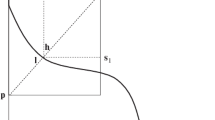Abstract
Power control based on signal-to-interference ratio (SIR) has been proposed as a technique for managing cochannel interference due to frequency reuse in a time-division multiple-access (TDMA) radio system. Early studies have focused on SIR balancing approaches that require centralized control for global power adjustment and/or associated channel reassignment or call admission control. This paper investigates the achievable performance of an autonomous power control technique which relies only on a simple fixed-step feedback adjustment algorithm. Simulation results, assuming no adaptation to Rayleigh fading, indicate that this simple power control technique can perform nearly as well as ideal SIR balancing/call removal, yielding a possible increase in spectrum efficiency of at least three times compared to a system without power control. Tracking of Rayleigh fading is found to provide an additional improvement in SIR of 4 to 4.5 dB for the range of fading rates expected in the pedestrian wireless access environments. This work is targeted toward understanding the traffic capacity and deployment implications of wireless technology alternatives that could provide access to local exchange networks.
Similar content being viewed by others
References
IEEE Communications Magazine, Special Issue on PCS: The Second Generation, Vol. 30, 1992.
T. Fujii and M. Sakamoto, Reduction of cochannel interference in cellular systems by intra-zone channel reassignment and adaptive transmitter power control,Conference Record IEEE VTC'88, Philadelphia, PA, 1988, pp. 668–672.
J. Zander, Performance of optimum transmitter power control in cellular radio systems,IEEE Transactions on Vehicular Technology, Vol. VT-41, pp. 57–62, 1992.
J. M. Aein, Power balancing in systems employing frequency reuse,COMSAT Technical Review, Vol. 3, No. 2, pp. 277–299, 1973.
R. W. Nettleton, Traffic theory and interference management for a spread spectrum cellular mobile radio system,Conference Record IEEE ICC'80, Seattle, WA, 1980, pp. 24.5.1–24.5.5.
R. W. Nettleton and H. Alavi, Power control or a spread spectrum cellular mobile radio system,Conference Record IEEE VTC'83, Toronto, Ontario, Canada, 1983, pp. 242–246.
J. Zander, Distributed cochannel interference control in cellular radio systems,IEEE Transactions on Vehicular Technology, Vol. VT-41, pp. 305–311, 1992.
M. C. Chuah, S. Nanda, and W. S. Wong, Squeezing out capacity with joint power-control and channel assignment,Fourth WINLAB Workshop on Third Generation Wireless Information Networks, East Brunswick, NJ, 1993.
A. Ariyavisitakul, SIR-based power control in a CDMA system,Conference Record IEEE GLOBECOM'92, Orlando, FL, 1992, pp. 868–873.
Bellcore Technical Advisories,Generic Framework Criteria for Universal Digital Personal Communications Systems (PCS), FA-NWT-001013, Issue 2, 1990.
P. D. Rasky, G. M. Chiasson, and D. E. Borth, An experimental slow frequency-hopped personal communication system for the proposed U.S. 1850–1990 MHz band,Conference Record IEEE ICUPC'93, Ottawa, Canada, 1993, pp. 931–935.
See, for instance, S. S. Haykin,Adaptive Filter Theory, Prentice-Hall, 1986, Chap. 5.
W. C. Jakes, Jr., Ed.,Microwave Mobile Communications, Wiley, New York, 1974.
D. C. Cox, Universal digital portable radio communications,Proceedings of IEEE, Vol. 75, pp. 436–477, 1987.
R. C. Bernhardt, Two-way transmission quality in portable radio systems,Conference Record IEEE GLOBECOM'88, Hollywood, FL, 1988, pp. 1331–1336.
R. C. Bernhardt, Time-slot management in digital portable radio systems,IEEE Transactions on Vehicular Technology, Vol. VT-40, pp. 261–272, 1991.
J. Chuang, Performance limitations of TDD wireless personal communications with asynchronous radio ports,IEE Electronics Letters, Vol. 28, No. 6, pp. 532–533, 1992.
S. Ariyavisitakul and L. F. Chang, Signal and interference statistics of a CDMA system with feedback power control,Conference Record GLOBECOM'91, Phoenix, AZ, 1991, pp. 1490–1495;IEEE Transactions on Communications, Nov. 1993.
S. Ariyavisitakul, Signal and interference statistics of a CDMA system with feedback power control. Part II,IEEE Transactions on Communications, Feb. 1994.
L. J. Greenstein, private communication.
D. C. Cox, Cochannel interference considerations in frequency reuse small-coverage-area radio systems,IEEE Transactions on Communications, Vol. COM-30, pp. 135–142, 1982.
Y. S. Yeh and S. C. Schwartz, Outage probability in mobile telephony due to multiple log-normal interferers,IEEE Transactions on Communications, Vol. COM-32, pp. 380–388, 1984.
S. Ariyavisitakul and L. F. Chang, Performance of unequalized frequency-hopped TDMA on dispersive fading channels,Conference Record IEEE GLOBECOM'93, Houston, TX,1993;International Journal of Wireless Information Networks (to appear).
A. R. Noerpel, Hybrid signaling for the air interface for a wireless access communications system,Conference Record IEEE ICUPC'92, Dallas, TX, 1992.
J. Chuang and N. R. Sollenberger, Uplink power control for TDMA portable radio channels,Conference Record IEEE ICC'93, Geneva, Switzerland, 1993; alsoIEEE Transactions on Vehicular Technology (to appear).
R. B. Cooper,Introduction to Queueing Theory, North-Holland, New York, 1981.
Author information
Authors and Affiliations
Rights and permissions
About this article
Cite this article
Ariyavisitakul, S. Autonomous SIR-based power control for a TDMA radio system. Int J Wireless Inf Networks 1, 187–198 (1994). https://doi.org/10.1007/BF02107418
Issue Date:
DOI: https://doi.org/10.1007/BF02107418




